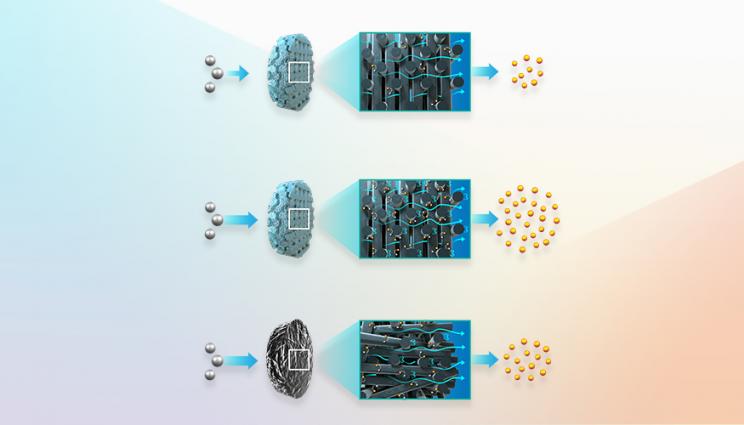(LLNL optimizes flow-through electrodes for electrochemical reactors with 3D printing)
2021-08-02 アメリカ合衆国・ローレンスリバモア国立研究所(LLNL)

・ LLNL が、電気化学リアクタのコアな構成要素であるフロースルー(貫流)電極(FTEs)を初めて 3D プリティングで作製する技術を開発。
・ LLNL では、燃料やポリマーへの CO2 の変換や、カーボンフリーで再生可能なエネルギー源による電力の電気化学的エネルギー貯蔵等の幅広いアプリケーションでの電気化学リアクタの利用について研究を進めている。本研究の成果により、高コストの工業製造技術に頼らずに、3D プリント電極の有効性を迅速に調査できるようになる。
・ 本研究のプリント材料には、グラフェンエアロゲルを使用。3D プリンティングによる自由な設計を通じ、FTEs から反応表面への大量の液体・ガス反応物質移動を実現した。実用的で柔軟かつ高速のFTEs プロトタイプ作製方法としての、また、リアクタ性能を最大化する手段としての 3D プリンティング技術の確立を促進する。
・ 高性能の新電極は、次世代電気化学リアクタ・アーキテクチャに不可欠な構成要素。本研究では、3D プリンティングによる電極構造構築における制御可能性を活用して局所的な流体の流れを創出し、リアクタの効率を向上させる複雑な慣性流動パターンが引き起こせることを実証した。
・ 3D プリンティングによる電極の流路形状の制御により、従来技術製造の FTEs にはないトレードオフを最小限に抑えながら電気化学反応を最適化できる。FTEs では一般的に炭素繊維ベースのフォーム等の「無秩序」な材料が使用され、微細構造の改良が制限される。また、製造は安価であるが、ランダムな構造の材料では不均一な流れや物質移動が起こる。
・ カーボンエアロゲル材料の 3D プリンティングにより、導電性や表面積等の物性を保持した微細孔ネットワークの構築が可能となる。直接インク書き込み(DIW)による 3D プリント作製した格子構造のFTEs では、過去の 3D プリント作製物に比べて物質移動が 1~2 桁向上し、従来材料による FETs と同等の性能を達成した。
・ 二光子リソグラフィー等の光ベースの 3D ポリマープリンティング技術を通じた、より高い解像度でのよりロバストな電極とリアクタ構成要素の製造を目指す。また、高性能コンピューティングを活用した優れた構造の設計と、より大規模で複合的なリアクタや電気化学電池での 3D プリント電極の利用を継続して実施する。
・ 本研究は、Laboratory Directed Research and Development プログラムを通じて実施された。
URL: https://www.llnl.gov/news/llnl-optimizes-flow-through-electrodes-electrochemical-reactors-3d-printing
<NEDO海外技術情報より>
(関連情報)
米国科学アカデミー紀要(PNAS)掲載論文(アブストラクトのみ:全文は有料)
Inertially enhanced mass transport using 3D-printed porous flow-through electrodes with periodic
lattice structures
URL: https://www.pnas.org/content/118/32/e2025562118
Abstract
Electrochemical reactors utilizing flow-through electrodes (FTEs) provide an attractive path toward the efficient utilization of electrical energy, but their commercial viability and ultimate adoption hinge on attaining high currents to drive productivity and cost competitiveness. Conventional FTEs composed of random, porous media provide limited opportunity for architectural control and engineering of microscale transport. Alternatively, the design freedom engendered by additively manufacturing FTEs yields additional opportunities to further drive performance via flow engineering. Through experiment and validated continuum computation we analyze the mass transfer in three-dimensional (3D)–printed porous FTEs with periodic lattice structures and show that, in contrast to conventional electrodes, the mesoscopic length scales in 3D-printed electrodes lead to an increase in the mass correlation exponent as inertial flow effects dominate. The inertially enhanced mass transport yields mass transfer coefficients that exceed previously reported 3D-printed FTEs by 10 to 100 times, bringing 3D-printed FTE performance on par with conventional materials.



